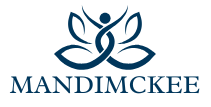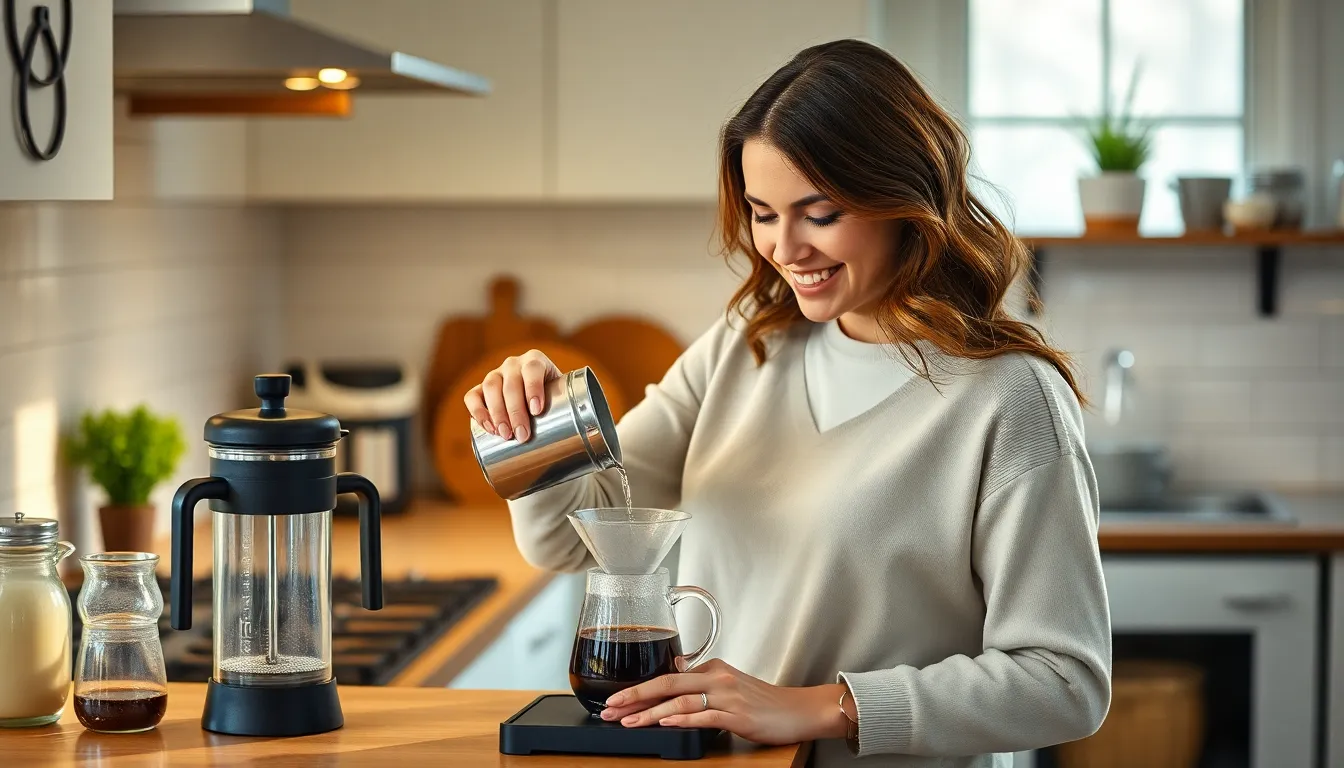For many, coffee isn’t just a drink; it’s a lifeline. The aroma wafting through the kitchen can turn even the grumpiest morning into a delightful experience. But let’s face it—brewing a perfect cup at home can feel like an Olympic sport. With so many methods and gadgets out there, how’s one to choose?
Fear not, aspiring baristas! Whether you’re a pour-over pro or a French press fanatic, mastering the art of home coffee brewing doesn’t have to be complicated. In this guide, you’ll discover the best ways to make coffee at home, turning your kitchen into a caffeine haven. Get ready to impress your taste buds and maybe even your friends—because who wouldn’t want to sip on a cup that rivals their favorite café?
Table of Contents
ToggleBest Way To Make Coffee At Home
Brewing a perfect cup of coffee at home involves several key elements. First, selecting high-quality whole beans enhances flavor; Arabica beans are often preferred for their smooth and complex profile. Second, grinding the beans just before brewing maximizes freshness and preserves essential oils.
Using the right equipment is crucial. French presses, pour-over cones, and espresso machines offer various brewing methods. Each method yields unique flavors, so experimenting is encouraged. For example, the French press produces a rich, full-bodied coffee while pour-over methods provide a cleaner, more refined taste.
Water temperature also impacts extraction. Ideal brewing occurs between 195°F and 205°F. Using filtered water enhances taste by removing impurities. Coffee-to-water ratio is another important factor, with a general guideline of 1:15 coffee to water, adjusting to personal preference.
Timing plays a role too. Brewing time varies depending on the method used. For a French press, steeping for four minutes achieves a balanced brew; a pour-over typically takes three to four minutes.
Finally, adjusting taste through additives can enhance flavor. Adding milk, cream, or sweeteners should complement rather than overshadow the coffee’s natural flavor. Taste testing different combinations leads to finding the perfect cup.
These elements combined create a satisfying experience when making coffee at home. Each variable can influence the final product significantly, making the process both nuanced and rewarding. Mastering these techniques leads to café-style coffee without leaving home.
Brewing Methods

Brewing coffee at home can be approached through several effective methods, each providing distinct flavors and experiences.
Drip Coffee Makers
Drip coffee makers simplify the brewing process for busy mornings. Users can add coffee grounds to a filter, fill the machine with water, and set it to brew. Most models automatically heat the water to the ideal temperature, usually around 200°F. A standard coffee-to-water ratio of 1:15 works best, yielding flavorful results. Convenience is the main advantage, making it a popular choice for many households.
French Press
French press offers a rich and robust flavor profile. This method utilizes a cylindrical glass or stainless-steel container and a plunger mechanism. Coffee grounds steep in hot water for about four minutes before pressing down the plunger. The full immersion brewing method extracts essential oils, resulting in a thicker and more aromatic cup. Experimenting with steeping times can enhance personal preferences, making this method versatile.
Pour Over
Pour-over coffee provides precise control over the brewing process. Utilizing a cone-shaped dripper, the user manually pours hot water over coffee grounds. This method allows for even saturation and optimal extraction of flavors. Typically, a ratio of 1:16 is recommended to achieve a balanced taste. Pouring technique significantly affects the final result, enabling drinkers to customize their brewing experience.
Espresso Machines
Espresso machines create a concentrated coffee shot characterized by rich flavors and a creamy texture. They force hot water through finely ground coffee under high pressure. A standard espresso shot requires about 18-20 grams of coffee and produces a 1-ounce serving. Mastering the grind size and tamping technique greatly influences consistency. Both novice and experienced baristas appreciate espresso for its versatility in crafting various coffee drinks.
Coffee Beans Selection
Selecting the right coffee beans is essential for brewing great coffee at home. Understanding the differences in bean types and freshness ensures a flavorful experience.
Arabica vs. Robusta
Arabica beans account for about 60-70% of global coffee production. These beans feature a smooth, nuanced flavor profile, often with hints of sweetness and acidity. Robusta beans, on the other hand, contain higher caffeine levels and produce a strong, bitter taste. Many coffee enthusiasts prefer Arabica for its delicate flavors. However, Robusta offers a bold option often used in espresso blends. Choosing between these two types depends largely on personal preference and desired coffee characteristics.
Freshness and Grinding
Freshness significantly impacts the flavor of coffee. Purchase whole beans rather than pre-ground options to maintain the best taste. Grinding beans just before brewing maximizes their aroma and flavor intensity. A burr grinder is recommended, as it provides a consistent grind size. Aim for a medium grind for drip coffee makers, while espresso requires a fine grind for optimal extraction. Ultimately, the right grinding technique enhances the overall brewing experience, ensuring that every cup delivers its best flavor.
Water Quality
Water quality significantly impacts coffee flavor. Using clean, fresh water elevates the brewing process and enhances the overall experience.
Using Filtered Water
Filtered water improves taste by removing impurities. Contaminants like chlorine can negatively affect flavor and aroma. When selecting water, consider using a carbon filter or bottled water. Each option offers clarity, which allows the coffee’s natural notes to shine. Additionally, mineral content plays a role; optimal levels can contribute to balanced extraction. For the best results, aim for water with a total dissolved solids level around 150 mg/L.
Temperature Considerations
Temperature directly influences coffee extraction. The ideal brewing range lies between 195°F and 205°F. Water hotter than this can lead to over-extraction, producing bitter flavors. Conversely, cooler water results in under-extraction, yielding a sour taste. Heaters built into coffee makers usually maintain this range effectively. For manual methods like pour-over or French press, monitoring the temperature is crucial. Using a thermometer ensures accuracy, leading to better brews that highlight the coffee’s characteristics.
Tips For the Perfect Cup
Crafting the ideal cup of coffee involves mastering a few key principles. Optimal ratios and precise timing enhance flavor, making each sip enjoyable.
Ratio of Coffee to Water
A balanced coffee-to-water ratio is essential for flavor development. Most experts recommend using a ratio of 1:15 for a standard brew. For example, using 30 grams of coffee to 450 milliliters of water works well for drip brewing. Adjusting the ratio can change the strength of the coffee. Stronger coffee may require a ratio of 1:14, while milder tastes might benefit from 1:16. Measuring accurately can significantly influence the final taste, leading to satisfying results.
Timing and Brewing Techniques
Timing plays a vital role in the brewing process. For French press, steeping for four minutes ensures a rich flavor. Pour-over techniques often require around three to four minutes for optimal extraction. Espresso shots typically take 25 to 30 seconds to brew, highlighting differences between methods. Experimenting with these times allows coffee lovers to discover their preferred balance between strength and subtlety. Additionally, remaining attentive to brewing techniques enhances consistency, fostering a rewarding coffee experience at home.
Brewing coffee at home can transform daily routines into delightful rituals. By focusing on quality beans and mastering various brewing techniques anyone can create café-worthy coffee in the comfort of their kitchen.
Experimenting with methods like French press or pour-over allows for a personalized touch that enhances flavor and enjoyment. Paying attention to factors like grind size water quality and brewing time ensures each cup is crafted to perfection.
With a little practice and the right approach anyone can elevate their coffee experience and impress friends and family with expertly brewed cups. So grab those high-quality beans and start brewing the perfect cup today.




